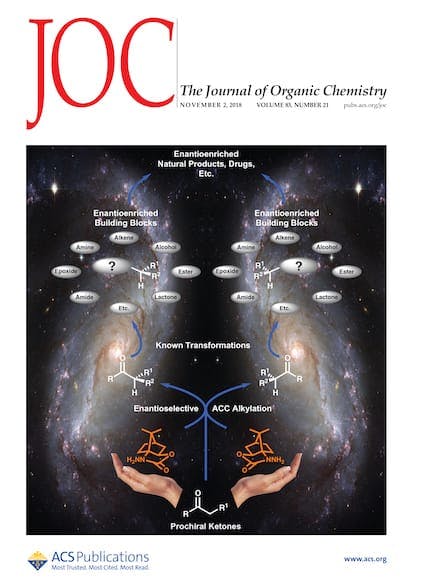Cosponsored by the ACS Division of Organic Chemistry and The Journal of Organic Chemistry, this annual award recognizes authors of an outstanding article published in the journal in the previous calendar year. The article is selected based on its creativity and impact in the field. Meet the Recipients The research group of Professor Ju Hyun […]

Cosponsored by the ACS Division of Organic Chemistry and The Journal of Organic Chemistry, this annual award recognizes authors of an outstanding article published in the journal in the previous calendar year. The article is selected based on its creativity and impact in the field.
Meet the Recipients
The research group of Professor Ju Hyun Kim at Gyeongsang National University is recognized for their exceptional article, Transition Metal-Free, Methoxide-Catalyzed Synthesis of Pyridoindolones, which presents simple ecofriendly reaction conditions for efficient synthesis of a new series of N-fused indoles as potentially useful framework molecules in medicinal chemistry.
Ju Hyun Kim graduated with a B.S. in chemistry from Ewha Womans University (2007) and received her M.S. (2009) and Ph.D. (2013) under the supervision of Prof. Sang-gi Lee. She then worked in the same group at Ewha Womans University as a researcher and a research professor (2014). Kim carried out postdoctoral research at Westfälische Wilhelms-Universität Münster in the laboratory of Prof. Frank Glorius (2016). In 2016, she joined the Department of Chemistry at Gyeongsang National University as an assistant professor. Her major research interests are homogeneous catalysis and reaction design for sustainable chemical transformations.
Learn more about the group by reading the highlights from our interview.
What does it mean to you to be the recipient of this award?
It is viewed as a great honor for our group. It feels as though something truly amazing has happened to us. Because The Journal of Organic Chemistry (JOC) is a long-established and authoritative publication within the field of organic chemistry, it is extremely meaningful to us that our paper has been recognized by JOC.
What prompted you to study this field of chemistry?
Our research group focuses on the development of efficient and practical synthetic methods for useful compounds within a number of potential industries. In particular, we are currently aiming to develop sustainable organic transformations that produce negligible (or zero) by-products via the use of minimal synthetic steps and chemical reagents. As such, our main research topic at the present juncture is catalytic C-H bond-activation reactions.
For this particular manuscript, identification of the pyridoindolone product and reaction mechanism can be viewed as a type of serendipity. When we worked on cobalt-catalyzed C−H alkenylation using N-pyrimidyl indoles and cyclopropenes, we tried to remove pyrimidyl directing group (DG) from the 2-alkenylindole product in the presence of an excess methoxide base. At that time, we did not know what the isolated product was, and our team was disappointed that the desired product was not ultimately detected. We unfortunately observed the same product once again when double-bond isomerization of an alkenyl indole was attempted using various bases. Subsequently, we attempted to identify the structure of the product that was being attained and found that the pyrimidine group migrated to have a quaternary carbon, and a cyclic compound was then formed after the leaving group was removed. Ultimately, the team came up with a mechanism for the migration of pyrimidine groups and cyclization through intramolecular SNAr. Additionally, we envisioned using a methoxide leaving group as the base for this transformation in order to maximize sustainability. Leaving groups in cyclization reactions are typically discarded as waste; as such, we attempted to utilize them as a base in order to minimize the employment of chemical reagents.
What are some of the important applications that you are working on that will benefit society?
Rearrangement is a powerful synthetic tool that can convert an ‘‘easy-to-prepare’’ precursor into a desired ‘‘difficult-to-make’’ product. In particular, it is a synthetic strategy that guarantees 100% atom-economy and regioselectivity. As sustainable chemistry becomes increasingly more important, rearrangement strategies should be receiving renewed attention.
Among potential rearrangement scenarios, the “Truce–Smiles” scheme is one of the most useful synthetic strategies for arene-functionalization using a carbanion nucleophile. Although it has been known of for decades, its mechanisms and synthetic applications have not yet been fully investigated or realized. Such being the case, the potential for future applications within the realm of compound-synthesis including heterocycles appears to be limitless.
Tell us about your research philosophy.
Organic chemists should focus on developing eco-friendly synthetic methods in response to the worldwide pollution and energy shortage problems that societies are presently facing, and we believe that there can be surprising innovations to legacy chemical reactions that were discovered/developed during previous eras of scientific inquiry. Thus, our team constantly strives to learn as much as possible from not only recent research papers but also from documented legacy chemical reactions extracted from mainstream organic chemistry textbook sources.
What’s next in your research?
Our team plans to further expand its research of synthesis reactions via SNAr mechanisms. As part of this quest, a catalytic reaction is presently being developed in which DG-assisted C-H bond functionalization followed by DG migration (without the use of an extra base) can be successfully utilized.
In addition, we are currently interested in organic transformations involving various types of rearrangement(s). For example, dual catalytic reactions involving a Claisen-type rearrangement have been developed and are planned for publication in the near term.
Explore Professor Kim’s recently published articles in ACS Publications Journals.
